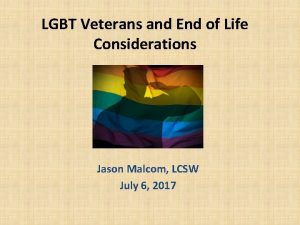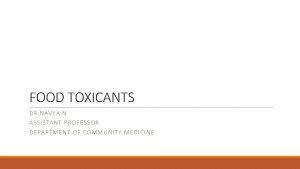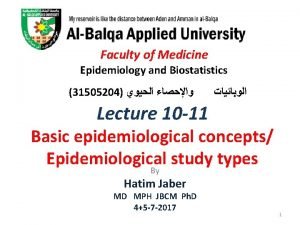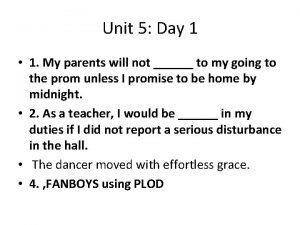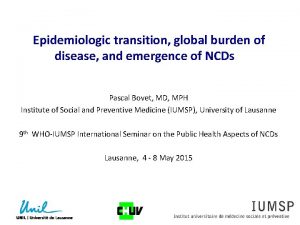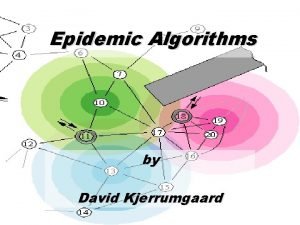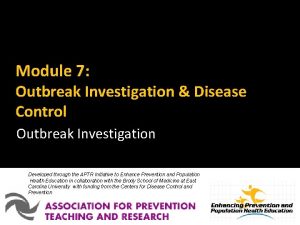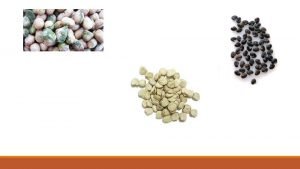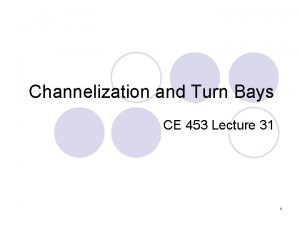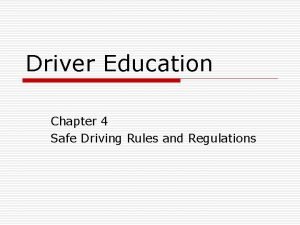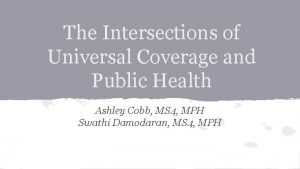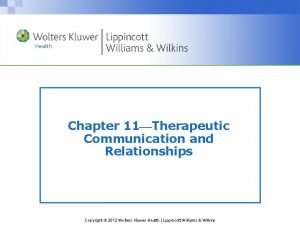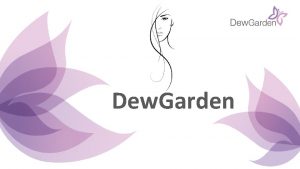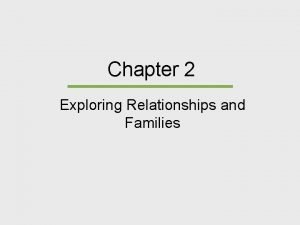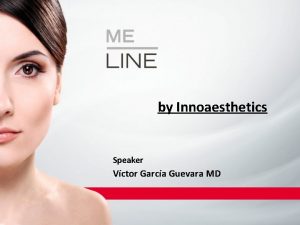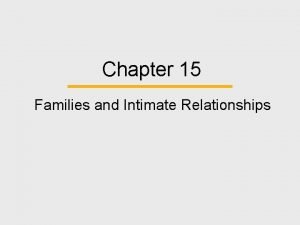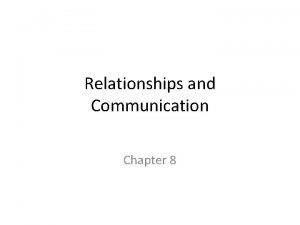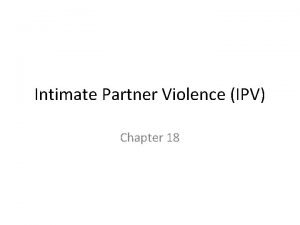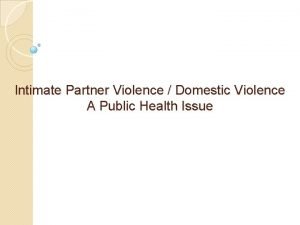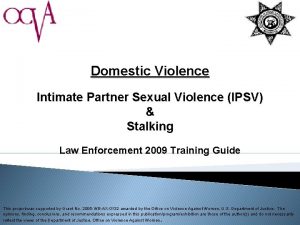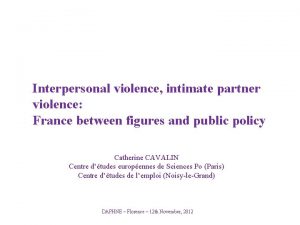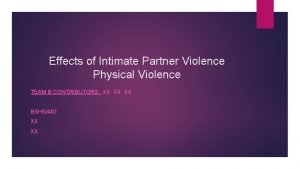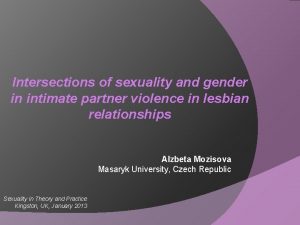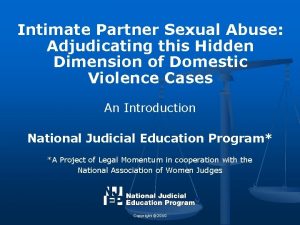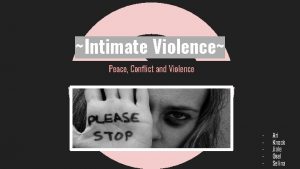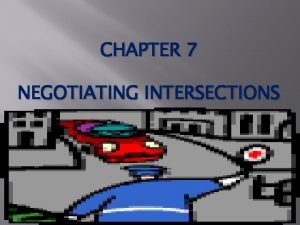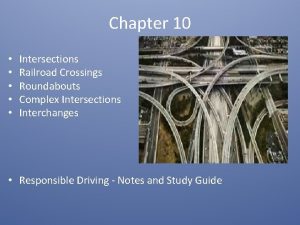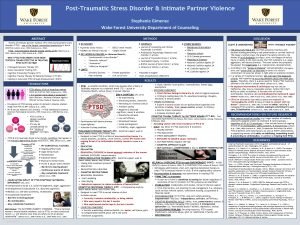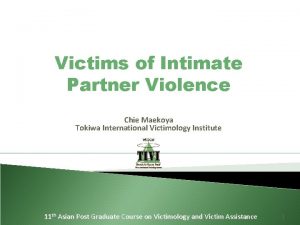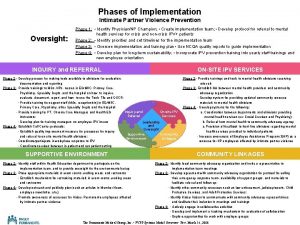The Hidden Epidemic Intersections of Intimate Partner Violence



































- Slides: 35

The Hidden Epidemic: Intersections of Intimate Partner Violence, Chronic Pain and SUDs EMILY FANJOY, TILLAMOOK COUNTY WOMEN’S RESOURCE CENTER SARAH FRANKLIN, HAVEN FROM DOMESTIC AND SEXUAL VIOLENCE DR. KATE MCKENNA, ONE COMMUNITY HEALTH & PROVIDENCE HOOD RIVER FAMILY MEDICINE RESIDENCY RURAL TRAINING PROGRAM, FAMILY MEDICINE & CORE FACULTY

Presentation Objectives §Review legal vs. public health definitions of Intimate Partner Violence (IPV) §Explore intersections of IPV and chronic pain, substance use §Share tools for addressing these health and IPV intersections §Discuss health care and community based advocate partnerships 2

Intimate Partner Violence (IPV) Legal vs. Public Health Definitions One person in a relationship is using a pattern of methods and pattern tactics to gain and maintain power and control over the other person. control Leaving is not always the best, safest or most realistic option for survivors. 3

Power & Control Wheel Developed by: Domestic Abuse Intervention Project 202 East Superior Street Duluth, MN, 55802 218 -722 -4134 Produced and distributed by:

Prevalence: Framing the Issue §Along with systemic racism and 6 other priority issues facing Oregon women and girls, violence is one of the “Count Her In” report “ 8 That Can’t Wait” for 2016. §An estimated 1 million Oregon women and girls— over half the states female population--have experienced some form of sexual or domestic violence. 5

Gender and Sexual Orientation Disparities § 61% of bisexual women and 37% of bisexual men experienced rape, physical violence, and/or stalking by an intimate partner in their lifetime. § 44% of lesbian women and 26% of gay men experienced rape, physical violence, and/or stalking by an intimate partner in their lifetime. §Of transgender individuals, 34. 6% reported lifetime physical abuse by a partner and 64% reported experiencing sexual assault. (Source: 2010 CDC National Intimate Partner and Sexual Violence Survey) 6

Racial Health Disparities also known as inequities Health disparities are the direct result of structural oppression, implicit and explicit bias, and racism

Comprehensive Prevention Substance Abuse Depression & Anxiety Teen Pregnancy Violence Prevention Delinquency School Dropout

Reproductive Coercion §Sexual Coercion §Birth Control Sabotage §Pregnancy Pressure

IPV & Co-morbid Health Conditions Chronic Black &Breiding, 2008; Campbell et al, 2002; Coker et al, 2000; Constantino et al, 2000; Follingstad, 1991; Kendall-Tackett et al, 2003; Letourneau et al, 1999; Wagner et al, 1995; Coker et al, 2000; Drossman et al, 1995; Lesserman et al, 2007; Kernicet al, 2000; Talley et al, 1994 Black & Breiding, Obesity, 2008; Bailey, B, 2012 • Arthritis • High cholesterol • Asthma • Heart disease • Headaches and migraines • • Back pain • Stroke • Chronic pain syndromes • Depressed immune function • Genitourinary problems • Irritable bowel syndrome Overweight/Obese Acute (Arias & Corso, 2005, Chrisler & Fergun, 2006) Chrisler & Ferguson, 2006 Abbott et al, 1995; Coker et al, 2002; Frye et al, 2001; Goldberg et al, 1984; Golding et al, 1999; Mc. Leer et al, 1989; Stark et al, 1979; Stark & Flitcraft, 1995) • Traumatic Brain Injury • • Strangulation • Broken bones • lacerations Spinal cord injuries

Psychological Abuse: a predictor of Physical Health Psychological abuse is as important a predictor of health as physical abuse, and was associated with a number of adverse health outcomes, including: § a disability preventing work § arthritis §chronic pain §migraines

IPV & Behavioral Health Co-morbidities More than one-third of female IPV survivors experience high disability chronic pain. § Anxiety/Panic Attacks § Sleep problems § Memory loss § PTSD § Depression § Suicide ideation/actions Wuest et al, 2008 (Women’s Health Effect Study) § Alcohol, drug, tobacco use Bergman &Brismar, 1991; Coker et al, 2002; Dienemann et al, 2000; Elsberg et al, 2008; Kernic et al, 2000; Stark &Flitcraft, 1995; Sato-Di. Lorenzo& Sharps, 2007 ; Lemon et al, 2002; Ackard et al, 2003 Weinsheimer et al, 2005; Kaysen et al, 2007; Miller et al, 1989; Plichta, 1992 12

Substance Use & IPV §In a study of men and women entering substance abuse treatment, 47% of the women reported having experienced victimization by an intimate partner at some point in their lives (Schneider & Burnette, 2009). §Another study of women accessing substance abuse treatment services found that approximately 67% reported experiencing physical IPV in the past 6 months (Downs, 2001). § A study of women who use injectable drugs found that 31% reported experiencing physical and sexual IPV in the previous year (Wagner et al. , 2009). § A study of women who attended a methadone clinic found that 90% had experienced IPV in their lifetime (Engstrom, El-Bassel, Gilbert, 2012).

Stigma Leads to Coercion https: //wisewisconsin. org/blog/what-is-stigma/

Stay awake/ Use with partner as risk reduction Create a private mental space Lack of access to mental health services evade assault Energy to get things done Survivor’s use of substance Create a sense of strength or control Cope with pain/ injury Cope with trauma & stress

Abusive Behavior and SUDS §The majority of people who use power and control behavior do not have a substance use disorder §The primary role that addiction plays in partner abuse is as an excuse for violent behavior §Abusiveness and addiction are two distinct problems requiring separate solutions Lundy Bancroft, Why Does He Do That?

NCDVTMH Toolkit on Coercion http: //www. nationalcenterdvtrauma mh. org/publicationsproducts/coercion-related-to-mentalhealth-and-substance-use-in-thecontext-of-intimate-partner-violence-a -toolkit/

Substance Use Coercion National Domestic Violence Hotline & NCDVTMH Survey N=3224 27% §Pressured or forced to use alcohol or other drugs, or made to use more than wanted Afraid to call the police for help because partner said 24. 4% §they wouldn’t believe you because of using, or you 26% would be arrested for being under the influence? §Ever used substances to reduce pain of partner abuse? 15. 2% §Tried to get help for substance use? 60. 1% §If yes, partner or ex-partner tried to prevent or discourage you from getting that help? 37. 5% §Partner or ex-partner threatened to report alcohol or other drug use to someone in authority to keep you from getting something you wanted or needed? Warshaw C. , Lyon E. , Bland P. , Phillips H. , Hooper M. , NCDVTMH/NDVH 2014

Opioid Use & IPV Abusers control treatment & medication & sabotage recovery Abusers actively undermine their partners' sanity, sobriety, & parenting IPV/SA & other trauma associated with increased OU/SU & MH effects Impact on Survivor & children Punitive responses, lack of access to IPV & trauma informed OUD treatment increase abusers’ control Abusers use OU/SU to control their partners & undermine credibility & access to support Stigma compounds these risk, i. e. CPS & criminal justice involvement

Health Care Use 17% of abused women reported that a partner prevented them from accessing health care (Mc. Closkey et al, 2007)

Healthcare Cost of IPV § A 2009 study of more than 3, 000 women in a Pacific Northwest based health plan found costs for women suffering ongoing abuse were 42% higher when compared with non-abused women. (Bonomi, 2009) § 12% of Medicaid-eligible women in a study sample were currently experiencing more severe IPV and the average cost of care was twice as high for this group as those not currently experiencing IPV (Coker, 2004) 21

Health Care Use Women who experienced psychological IPV were significantly more likely to report their physical health and their mental health to be poor. Women who experienced physical IPV were more likely to report poor physical and mental health and to have more than 5 physician visits in the last year. Coker et al, 2000

When Healthcare Responds Women who talked to their healthcare provider about abuse were § 4 x more likely to use an intervention § 2. 6 x more likely to exit an abusive relationship (Mc. Closkey et al, 2006) 23

National Health Resource Center on IPV Provides free technical assistance and tools including: • Advocate toolkit with slides, video vignettes and sample forms/MOUs • Posters, Health care clinical tools and pregnancy wheels • Patient education safety cards • Brochure for survivors to improve health access and support traumainformed health visits • Videos and brochures on IPV and impact on children Phone: 415 -678 -5500 www. ipvhealth. org

Evidence Based Screening & Referral to Advocate: Futures Without Violence intervention §Developed for medical providers and advocates to use with survivors §Designed as a prompt for universal education § Is trauma informed and provides an opportunity for primary, secondary and tertiary prevention 25

Bringing Clinics into Futures Without Violence: A partnership between a local DV/SA agency and rural community health centers in The Gorge • New MAT program exposed high rates of IPV • Collaborated with local DV/SA agency to put on workshops/conference series • Quality Improvement to improve universal education increased screening by > 50% in the last year! • FQHC’s hired a social worker from local DV agency as case manager to work with the clinics’ high risk populations, including MAT

Health Care & Community Partnerships Build Resilience Provider Quotes "I think that this has been a real game changer for me. . . Not just another screening. . . This project has helped me see how this is significant and problem solve to make it happen. ” “I have stepped outside my comfort “Having someone available who zone. I still have a long way to go. ” has significant experience working with families has been a gift to us. "

Why Community Based Advocates? §Advocates work from a social justice, equity lens. §Advocates are trained professionals specializing in dynamics and tactics of IPV/SA and systemic oppression with specific VAWA confidentiality and privilege in Oregon. §Advocates services are survivor led as advocates support survivors to navigate the complex impacts of violence and access critical services.

6 Principles of Harm Reduction

Advocate Tracking Tool 64 unique clients, 374 contacts

Survivor Interviews §After the abuser was arrested, a survivor was traumatized and her “brain wasn’t working. ” It would have been very difficult for her to remember all the things she had to do to qualify for assistance. §Another survivor said that because of the advocate “my baby didn’t die. ” The advocate worked with multiple systems to secure protective orders for stalking behavior and verbal threats. This helped the woman control her stress levels in order to eat and gain weight during her pregnancy. §Advocates encourage women to advocate for themselves. A survivor credited the advocate with helping her “to be able to do it myself”. 31

Recommendations Address both safety and substance use as top priorities. Get to know your local sobriety supports and chronic pain clinics: § Call and meet each other § share resources § cross-train Current approaches to collaboration: §Formalized partnership with on-call advocate §Co-locating positions §Multi-disciplinary teams §Co-leading of group or facilitating a group on-site Rose, 2016

Social support is a biological necessity, not an option, and this reality should be the backbone of all prevention and treatment. Dr. Van Derkolk

Additional Information Oregon Guide to Health Care Partnerships: For community-based organizations and advocates supporting survivors of domestic violence in health care settings https: //www. ocadsv. org/blog/post/hidden-epidemic-intersectionstrauma-and-opioids www. Futureswithoutviolence. org www. ipvhealthpartners. org https: //www. youtube. com/user/Futureswout. Violence

Contacts and Resources: EMILY FANJOY, TILLAMOOK COUNTY WOMEN’S RESOURCE CENTER, 503 -842 -9486 | EMILY@TCWRC. NET SARAH FRANKLIN, LPC, NCC, HAVEN AGAINST DOMESTIC AND SEXUAL VIOLENCE COMMUNITY EDUCATION & COMMUNICATIONS PROGRAM COORDINATOR 541 -296 -1662 | SARAH@HAVENTHEDALLES. ORG DR. KATE MCKENNA, ONE COMMUNITY HEALTH & PROVIDENCE HOOD RIVER FAMILY MEDICINE RESIDENCY RURAL TRAINING PROGRAM, FAMILY MEDICINE & CORE FACULTY KMCKENNA@ONECOMMUNITYHEALTH. ORG
 Periwinkle doerfler
Periwinkle doerfler Aids epidemic
Aids epidemic Epidemic dropsy
Epidemic dropsy Endemic epidemic
Endemic epidemic Doctors attributed the epidemic to the rampant
Doctors attributed the epidemic to the rampant Obesity and bone health
Obesity and bone health David kjerrumgaard
David kjerrumgaard Endemic epidemic
Endemic epidemic Epidemic dropsy
Epidemic dropsy Bay taper
Bay taper Uncontrolled railroad crossings usually have
Uncontrolled railroad crossings usually have Negotiating intersections chapter 10
Negotiating intersections chapter 10 An uncontrolled railroad crossing usually has
An uncontrolled railroad crossing usually has Chapter 4 safe driving rules and regulations
Chapter 4 safe driving rules and regulations Union vs intersection
Union vs intersection Chapter 7 negotiating intersections
Chapter 7 negotiating intersections Module 5 intersections and roundabouts
Module 5 intersections and roundabouts At an open or uncontrolled intersection, yield if _____.
At an open or uncontrolled intersection, yield if _____. Module 5 topic 2 drivers ed
Module 5 topic 2 drivers ed Intimate family chapter 6
Intimate family chapter 6 Consultative register example
Consultative register example Intimate zone in communication
Intimate zone in communication What is intimate distance
What is intimate distance The impact of incarceration on intimate relationships
The impact of incarceration on intimate relationships Meaning of initmacy
Meaning of initmacy Relaxed antonym
Relaxed antonym Dewgarden foaming intimate wash benefits
Dewgarden foaming intimate wash benefits Friendly relationship chapter 7
Friendly relationship chapter 7 Intimate family chapter 2
Intimate family chapter 2 Me line 02 intimate
Me line 02 intimate Zones of space communication
Zones of space communication Intimate family chapter 6
Intimate family chapter 6 Family of orientation
Family of orientation Define the relationship ch 7
Define the relationship ch 7 Relationship guidelines chapter 8
Relationship guidelines chapter 8 Tư thế ngồi viết
Tư thế ngồi viết

